Roguelikes: How a Niche PC RPG Genre Went Mainstream
HISTORY OF RPGS | Mystery Dungeon tackled the daunting task of making roguelikes friendly.
This article first appeared on USgamer, a partner publication of VG247. Some content, such as this article, has been migrated to VG247 for posterity after USgamer's closure - but it has not been edited or further vetted by the VG247 team.
This is the seventh entry in an ongoing series by Retronauts co-host and Greenlit Content senior creative director Jeremy Parish exploring the evolution of the role-playing genre, featuring insights from the people who created the games that defined the medium.
Designing computer and console role-playing games has always been an imperfect art: The translation of a fundamentally social, human experience into one driven by computers. Tabletop RPGs use systems-based rules to dictate many aspects of a play session, so naturally the orderly nature of computers has railroaded the general definition of computer RPGs in a very specific direction. According to the collective consensus, computer and console RPGs should be story-driven adventures built around numeric, experience-based character growth. The freewheeling, improvisational nature of a memorable Dungeons & Dragons campaign led by a game master with a flair for narrative has been replaced in video games by predetermined storylines with fixed outcomes and, at best, a few branching decision trees that give the player a small amount of agency within those rigid boundaries.
This is unlikely to change significantly until some faraway day when machine learning reaches a point that allows computers to spin a convincing yarn all on their own. But there is one video RPG subgenre that does manage to capture the anything-goes, high-stakes unpredictability of a lively tabletop session: roguelikes. While light on actual narrative, these games are designed with the understanding that dynamic interactions and complex design alone can result in their own share of memorable stories.
The Beginning of Roguelikes
Roguelikes rely on a combination of random procedural generation and complex interlocking systems to provide players with an unpredictable take on the RPG. Roguelikes typically incorporate only a cursory storyline, emphasizing exploration and combat survival to a degree that eclipses even the classic first-person dungeon crawler. They operate according to strict rules, but the sheer breadth of items, weapons, and enemies that can appear during combat always keep players on their toes. Nearly every element the player encounters possesses the potential to interact with the world and everything else it contains—and while the resulting effects obey logical rules, the sheer number of possible interactions available within these rules can make it difficult for all but the most seasoned players to predict the full range of outcomes their actions might have. The fact that the dungeon and everything in it is generated afresh for each new session means no two adventures can ever play out the same way.
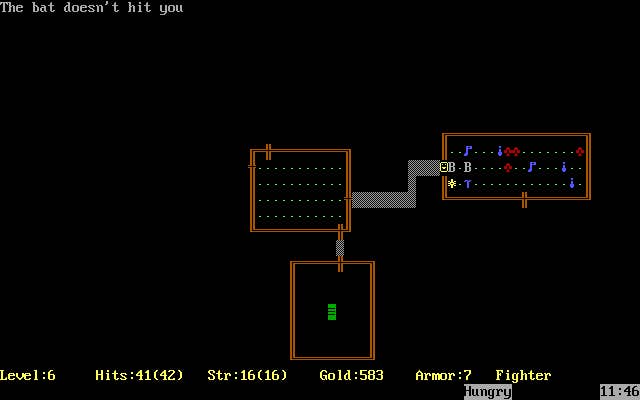
The roguelike got its proper beginning in the early ’80s thanks to two UC Santa Cruz students named Glenn Wichman and Michael Toy who created a deceptively simple-looking game called Rogue. The genre's roots actually stretch back even further, though; like Wizardry, Rogue had a fair few antecedents on the PLATO platform, the first of these appearing as early as 1975. However, unlike the ur-roguelikes of the PLATO ecosystem, Rogue wasn't limited to a closed, academic network. On the contrary, it saw a number of commercial releases throughout the ’80s. These versions failed to make an impression on the market, though, ultimately earning only a small number of devoted fans who would go on to create their own interpretations of Rogue's principles—hence "roguelikes"—but otherwise disappearing quietly from the mainstream gaming world as little more than a half-remembered blip in history.
No, the roguelike didn't enjoy anything approaching mainstream success until the creators of Dragon Quest at Chunsoft decided to do for that genre what they had already done for the traditional computer RPG: turn it into an approachable, console-friendly format that any gamer could enjoy. Both Rogue and its descendants—games like NetHack, Moira, Angband, and their own offshoots—typically took the form of abstract, frequently bewildering games. They used simple ASCII text for "graphics," with alphanumeric symbols representing in-game objects and characters. Despite being built around combat that amounted to bumping into a foe until it died, they also included so many commands and options that players needed to make use of an entire computer keyboard for shortcuts. Roguelikes were as unforgiving as they were difficult, with sessions spanning months potentially ending in a single turn due to bad luck... at which point all the player's progress was erased and they had to start back at the beginning of the game with an all-new character lacking even a sword to their name.
In fact, Rogue was so oblique that Chunsoft (now Spike Chunsoft) president and former Dragon Quest programmer Koichi Nakamura initially questioned the wisdom of trying to adapt it to consoles.
"We had just made [Super NES visual novel] Otogirisou, and a couple members of the team were really into the original Rogue. I hadn't played at the time, but those team members were like, 'Nakamura, we need to make Rogue—our own version of Rogue.' So I said, 'OK, let me see what this game's all about.'
"When you first start playing, it's utter nonsense,” he says. “You're an @ symbol moving around, fighting As and Bs and the like, the items are all question marks, and the levels are made up of hashtags and things like that. You're just wandering around like, 'What's going on? I don't get this. I don't know what's fun.'"
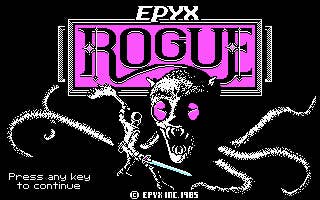
Eventually, though, Nakamura says he warmed to the game despite its opaque design, and he began to envision how this potential "Dragon Quest of roguelikes" could take shape. "I spent an entire 10-day Golden Week holiday playing Rogue, trying to figure out what is interesting about this game system, and it started to click over time. I realized if, let's say, I have two orange unidentified items and I use one and it's a potion of healing. Then I know the other orange item is the same thing. It becomes a matter of learning what the different items do, how those relate to the environment, and what the enemies are doing.
"For example, there's an item that halves the enemy's speed so I can attack twice for every time the enemy attacks once. I thought, 'I guess this is useful, but so what?' Then I realized I can hit, then move away, and then the enemy moves towards me... I'm invincible, right? If you have extra actions, it means you can dodge the enemy's attacks and hit them without them hitting you back. At that point, everything fell into place and I realized why the system was so intriguing. So we started thinking about: ‘How can we do this in our own way?’"
Making the "Dragon Quest of Roguelikes"
Chunsoft wasn't the first developer to have come up with the notion of a console adaptation of Rogue. Sega had made its own attempt to bring the roguelike to its Genesis (also known as Mega Drive) console in 1990 with a game called Fatal Labyrinth. A simplistic take on the genre, Fatal Labyrinth's format appears to have been a pragmatic choice by Sega to produce a role-playing title for their Japanese Meganet distribution service. As a downloadable game distributed in the days before broadband and expansive rewritable memory options, Fatal Labyrinth's procedural design and lack of any real built-in narrative allowed the game to offer expansive play value despite being contained in a tiny amount of memory space; this in turn reflects Rogue’s own design, which lacked graphics simply because it was created for play on shared text-only terminals. However, both Fatal Labyrinth and Dragon Crystal (its 8-bit downconversion for Master System and Game Gear) lacked the depth of a proper computer roguelike and failed to make much of an impression on gamers.
Nakamura, on the other hand, wanted to capture the substance of true roguelikes for consoles in a way Fatal Labyrinth had failed to achieve. He and his team decided to take a literal approach to “doing for roguelikes what Dragon Quest had done for RPGs” by making his roguelike an actual spinoff of the Dragon Quest series. Although Chunsoft was wrapping work on the fifth Dragon Quest chapter around this time, series lead Yuji Horii recommended they look back to the series' final 8-bit entry for inspiration: Dragon Quest 4.
The end result was a game whose protagonist was as unlikely as the prospect of transforming a genre geared toward hardcore PC gaming fanatics into something true to the genre while simultaneously being accessible to a young, casual console audience. Called Torneko no Daibouken: Fushigi no Dungeon (Torneko's Big Adventure: The Dungeon of Mystery), Chunsoft's interpretation of the roguelike retained key genre elements like item identification, procedural dungeon generation and item placement, and permanent character "death." But it starred one of Dragon Quest 4's most charismatic side characters, a portly middle-aged merchant whose efforts to support his family by running a humble weapons shop caused him to become swept up into a grand quest to save humanity.
"I figured that if we were to bring a roguelike to a console, we'd kind have to take a similar method to [our approach with Dragon Quest] by lowering the barriers of entry to get people interested in the game." says Nakamura. "There's a lot to take in at first, and if people get overwhelmed, they're not going to want to continue. I wanted to give the players a familiar setting, and the Dragon Quest setting was great for that because people were already familiar with the monsters and the items. So even if they didn't know how the game system works, they could kind of guess, you know? This monster will probably move this way. This item will probably have that kind of effect. So it's easier for them to get in and learn the nuts and bolts of the system from there.
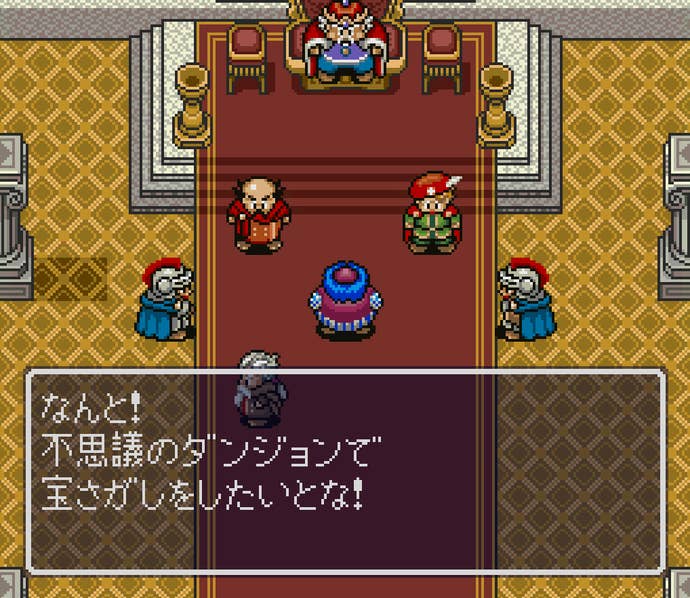
"I was able to talk to Horii and ask him, 'Hey, I want to make a roguelike. Can I use Dragon Quest as the framing device?' He said, 'Oh, yeah—roguelikes seem pretty interesting. Go ahead with it.' However, his advice was that we shouldn't go with a hero-like character. Heroes have this, so to say, sense of adventure. They have this grand mission they're supposed to be carrying out. If you're a guy slogging through a dungeon, that doesn't really fit into your typical hero archetype. But on the other hand, Torneko—he's a merchant, so it would make sense for him to go through these dungeons to gather up items and weapons and things like that for use later on."
By luck, Torneko's entire storyline dovetailed neatly with the concept of a roguelike. His chapter in Dragon Quest 4 (a game divided into multiple standalone scenarios highlighting its various party members) had seen him delving into dungeons as he sought out rare weapons to stock at his shop. His solo roguelike outing simply expanded on this, pitting him against familiar monsters and gathering what resources he could as he descended through challenging, procedurally generated caverns toward his objective.
Of course, being a Dragon Quest spinoff, the concept of permadeath had to be altered somewhat; one of that series' core innovations from the very beginning had been not to punish failure with a decisive game over screen. So Torneko doesn't die when he succumbs to enemies in the Dungeon of Mystery, but losing to the increasingly powerful creatures within does cause him to revert to level one as the dungeon generates an all-new layout for the player’s next run. Also, unlike a "true" PC roguelike, Torneko no Daibouken also introduced some more permanent elements—another suggestion by Horii to help ease casual players into a famously punishing genre.
"Permadeath is a big thing in roguelikes," says Nakamura. "The idea of adding shops to Torneko to give the player a sense of progression was actually proposed by Horii. In Dragon Quest, when you die, you don't lose your equipment and experience. You just lose half your gold. So he figured that, you know, if people are coming over to Mystery Dungeon from Dragon Quest, they're not going to stick around if they lose everything when they die. So we added a way to help a player out. Give the player some sort of a tangible reward for the amount of time they put into it—that was our way of thinking."
The Sensation of Mystery Dungeon
While Torneko no Daibouken didn't sell the millions of units typical to a core Dragon Quest title, it established Fushigi no Dungeon (eventually standardized as "Mystery Dungeon" in the U.S.) as a vital and vibrant franchise in its own right. Torneko has appeared in several sequels, as has Dragon Quest 8's rowdy thief Yangus. Chunsoft has also licensed out the Mystery Dungeon brand to create tie-ins with a number of other RPG franchises ranging from Pokemon to Final Fantasy; the Pokemon Mystery Dungeon games easily stand as the best-selling roguelikes of all time, with sales for each release reaching into the millions.
Ultimately, though, Chunsoft reserves its best Mystery Dungeon ideas for games starring the character they created for the second Mystery Dungeon title: Shiren the Wanderer, a ronin who travels through medieval Japan with his companion, a ferret named Koppa. "Torneko opened the doors to roguelikes for a whole new audience," says Nakamura. "It let people get acclimated to what a roguelike game system was. Because we had the familiar Dragon Quest setting, they could just focus on the game mechanics.
"The issue is that there are certain limitations built into the Dragon Quest world. In NetHack, you can go around and be a thief and steal things from people, but you wouldn't really want one of your Dragon Quest heroes to act like such a scoundrel. There are also some systems that we wanted to include that we couldn't do with the Dragon Quest setting. For example, Shiren has a 'meat' system where if you defeat an enemy, you can eat its meat and learn new skills. You can set your own traps, and things like that. Those were things that we thought would be cool but didn't fit into the Dragon Quest framework. Shiren was our way to kind of move away from that and do our own thing."
Chunsoft has only created about half a dozen unique Shiren titles and spinoffs through the years, but the depth and creativity of those games gives them remarkable longevity. Being a wholly original character, Shiren affords Chunsoft's designers a degree of freedom they can't explore with licensed properties. As a result, the Shiren games are probably the least-known entries in the Mystery Dungeon line, but they're unquestionably the richest and most creative.
Die-hard roguelike enthusiasts admittedly tend to regard the Mystery Dungeon games as lesser variants of the genre. The franchise fails to meet many of the elements defined in the Berlin Interpretation, the most widely accepted definition of the genre. Even Shiren doesn't meet all the high-value criteria, thanks to its lack of permadeath: Yes, Shiren has to start over from the beginning when you collapse in a dungeon, but the games offer ways to circumvent the loss of all his gear. You can hide equipment in special protective pots or store it in warehouses that retain persistence across journeys. It's even possible to upgrade weapons across multiple sessions so that Shiren can start a new run wielding stupendously powerful gear.
For his part, Nakamura doesn't seem especially concerned about meeting some sort of external genre criteria with Mystery Dungeon. The most important thing, he says, is that the games uphold the spirit of the roguelike format while remaining true to the team's vision. "I don't know if we've really sat down and said, 'What absolutely constitutes a roguelike?'" he admits, adding, "I do have my own theories about things that I think a roguelike should be. Notably, it should be something that you can play multiple times, and it should play differently each time. You don't know what will happen until you start the run.
"It's important to have consistent rules, and the items and equipment you have should follow these rules. There should be unexpected things you can do with items, within the rule system, but items should never break the system. Even if they do unexpected things, they should obey some kind of consistent logic. The way that humans react to [probability percentage and damage indicator] numbers they see on-screen versus the results they actually get is quite interesting, and it's one of the things that we're always working on underneath the hood. There's a lot of psychology behind the numbers.
The dynamism of Mystery Dungeon can surprise even its creators, Nakamura admits. He recalls a early playthrough in which he unwittingly discarded a container of valuable goods by attempting to break it against a wall while wearing a bracelet that caused projectiles to pierce obstacles. While these bracelets can come in handy during combat, allowing a thrown weapon to strike multiple foes in a line, they also cause items to pass through other barriers. Nakamura watched in horror as his precious loot sailed through the wall and off the edge of the screen.
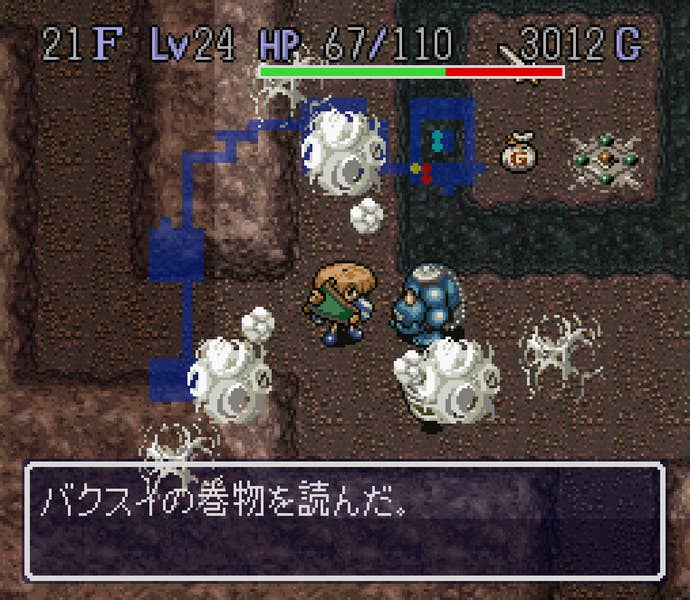
"You know,” he says, “I created the game, and I knew this was supposed to happen... but the first time it happened to me, I was like, 'What the hell? The game bugged out on me!' So I talked to the programmer, and he said, 'No, no, no. That's actually the way it's supposed to work because, you know, the ring makes things go through objects.' Those are the kinds of surprises that I like to see in roguelikes."
Perhaps the greatest testament to Shiren's quality is how influential it's been on other developers, or at least how many other developers have settled upon similar mechanics and concepts to those found in Mystery Dungeon. Roguelike elements began to work their way into other mainstream games most visibly with Blizzard's Diablo in 1997, and when Derek Yu's Spelunky arrived more than a decade later it caused people to reconsider what "roguelike" actually means. The likes of Spelunky and Rogue Legacy are barely recognizable as offshoots of Toy and Wichman's venerable dumb-terminal creation, but they nevertheless apply Rogue's philosophy to unrelated genres in fresh and clever ways.
Features like the permanent shortcuts players can unlock as they advance through Spelunky's caverns and the carried-over stats of Rogue Legacy are ideas that have their roots in Mystery Dungeon’s warehouse and long-term weapon-crafting. The classic ASCII-based roguelike format will never become a widespread hit, but its mechanics—filtered through the prism of Chunsoft's pioneering work—have become commonplace, especially in the lively and innovative indie gaming space.
Meanwhile, Chunsoft continues to explore new ground with the Mystery Dungeon titles. The most recent release in the series, Etrian Odyssey crossover Etrian Mystery Dungeon 2, launched in Japan in 2017. While Shiren himself hasn't gone on a new adventure since Shiren the Wanderer 5 in 2010 (2015's Shiren the Wanderer: The Tower of Fortune and the Dice of Fate was a remake of Shiren 5), Nakamura sees room for further sequels—provided the team can continue thinking up new innovations like Shiren 5's game-changing day and night system.
"Even before we hit Shiren 5, I figured we had reached the ultimate form of the roguelike," says Nakamura. "Talking to the development team, I asked, 'Where can we go from here, guys? We made Shiren 4. I think it's pretty much perfect.' The team was like, 'No, no, no. We can do more.' And the result of that was Shiren 5.
"I think there are still places the roguelike can go, and it all depends on what kind of options new technology brings us. For example, Torneko didn't have any kind of online connectivity, but on the DS Shiren games, there's online connectivity. If you die in a dungeon, you can have a buddy come save you. So it introduced this new element where even though it's a single-player game, you can still interact with other players. If there's some new technological advancement that we can incorporate into the game, that will open up new possibilities for the roguelike. The Shiren team is still very passionate about the series, so if there's ever an opportunity, I'm sure they'll be up to the task."
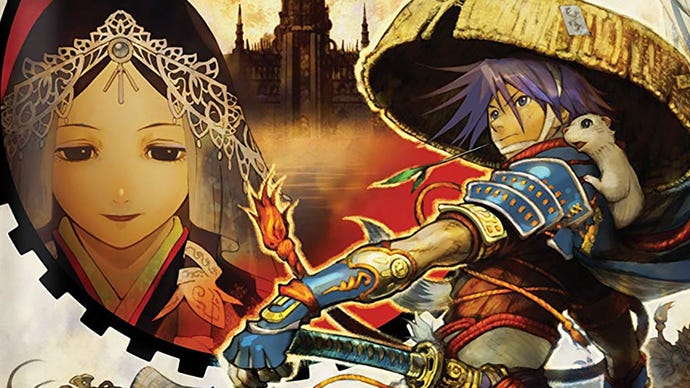




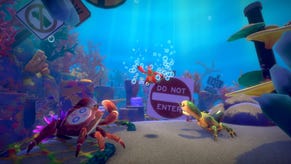
.jpg?width=291&height=164&fit=crop&quality=80&format=jpg&auto=webp)


